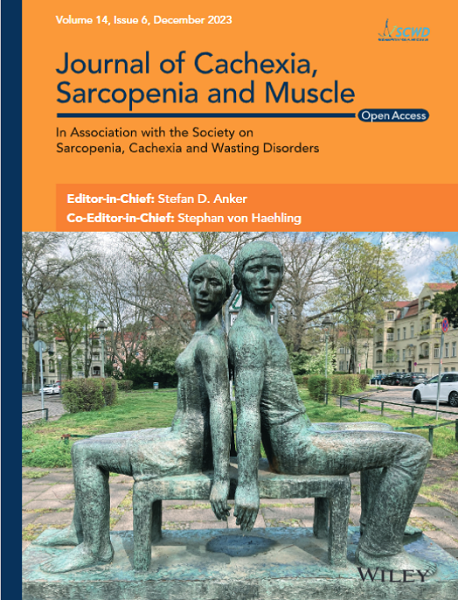SIRT6 Ameliorates Cancer Cachexia–Associated Adipose Wasting by Suppressing TNFR2 Signalling in Mice
Abstract
Background
Cachexia is a wasting syndrome associated with imbalanced energy metabolism and loss of adipose and muscle tissues and contributes to morbidity and mortality in ageing as well as in patients with severe chronic diseases, including cancer. At present, there are no treatments addressing cachexia that have reached validation to be used in the clinic. In this study, we investigate the protective role of SIRT6, an important regulator of energy homeostasis and health preservation, against Lewis lung carcinoma (LLC)–induced cachexia.
Methods
SIRT6 levels of serum from gastric cancer patients (n = 22, 65.27 ± 12.50 years old, 40.9% females) and healthy controls (n = 22, 63.50 ± 10.77 years old, 45.4% females) were measured to evaluate the correlation between circulating SIRT6 levels and cancer cachexia development. Ten-week-old SIRT6 transgenic (TG) and wild type (WT) male mice injected with LLC cells (1.5 × 106 per mouse) were used to investigate the protective effects of SIRT6 on cachexia-associated adipose browning and lipolysis and the underlying mechanisms. We explored the effect of SIRT6 on LLC-conditioned medium induced lipolysis in mature adipocytes, differentiated from primary mouse embryonic fibroblasts (MEFs). We evaluated the in vitro effect of a SIRT6 activator by treatment of MDL800.
Results
SIRT6 concentrations were significantly higher in non-cachectic cancer patients (3.41 ± 0.30 ng/mL) compared to cachectic cancer patients (3.20 ± 0.23 ng/mL, p < 0.01), suggesting the negative correlation between SIRT6 level and cachexia in patients with cancer. SIRT6 overexpression significantly ameliorated tumour-induced wasting and energy expenditure in white adipose tissues (eWAT mass loss: 66% in WT vs. 32% in TG; iWAT mass loss: 69% in WT vs. 40% in TG) through suppression of browning and lipolysis. In LLC-induced cachexia, tumour necrosis factor-α receptor 2 (TNFR2) mediated the inhibition of SIRT6 on lipolytic signalling, because the difference in lipolysis between the WT and SIRT6 knockout group was almost eliminated by TNFR2 neutralizing antibody. Increased serum TNFR2 concentration was found in cachectic cancer patients (690.41 pg/mL in non-cachectic vs. 1166.98 pg/mL in cachectic patients, p < 0.05). A selective SIRT6 pharmaceutical activator, MDL800, could completely reverse LLC-induced lipolysis in adipocytes.
Conclusion
We found an unexpected beneficial function of SIRT6 in cancer cachexia, demonstrating that increased SIRT6 expression or activity is capable of protecting the host against cachexia-associated tissue wasting, providing a concept of future therapies for cachexia.


 求助内容:
求助内容: 应助结果提醒方式:
应助结果提醒方式:


